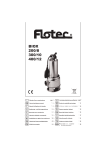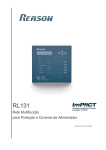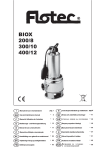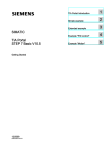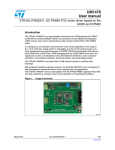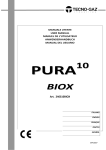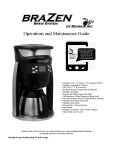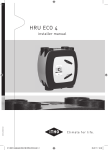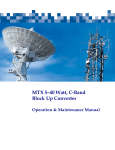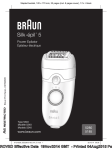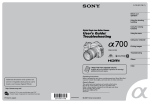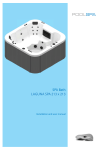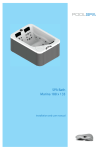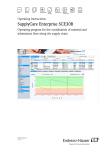Download BIOX-1015 - Axon Automation Inc.
Transcript
Operating Instructions BIOX-1015 10008003EA BA 834C/24/ae/04.07 BIOX-1015 1 TABLE OF CONTENT Introduction 1-1 1.1 BOD Theory of Operation 1-1 1.2 Basic Operating Sequence 1-1 1.3 Components and Their Functions 1-2 1.4 1.4.1 1.4.2 Operational Diagrams Peristaltic Pump P1 Handling Tips and Notes 1-9 1-11 1-12 1.5 1.5.1 1.5.2 1.5.3 1.5.4 1.5.5 1.5.6 1.5.7 Connections Mains Connection Computer Interface and Printer (options) Computer Interface and Printer (options) Signal Outputs (optional) Fresh Water Intake Sample Intake Electrical Connections 1-12 1-12 1-12 1-12 1-12 1-13 1-13 1-14 1.6 Technical Specifications 1-15 2 Safety Regulations 2-1 2.1 General Instructions 2-1 2.2 Safety Instructions 2-2 2.3 Safety Equipment 2-2 2.4 Informal Safety Measures 2-3 2.5 Personnel Training 2-3 2.6 Device Control 2-3 2.7 Hazards from Electric Power 2-3 2.8 Particularly Dangerous Parts 2-3 2.9 Maintenance Service and Trouble-shooting 2-3 2.10 Changes to Device 2-3 2.11 Cleaning Solution and Reagent Disposal 2-4 2.12 Disposal of the Analyzer 2-4 2.13 Device Noise 2-4 2.14 Copyright 2-4 Endress+Hauser page I TABLE OF CONTENT 3 Installation and Programming BIOX-1015 3-1 3.1 3.1.1 3.1.2 Set Up Installation Conditions Preparing for Set Up 3-1 3-1 3-1 3.2 3.2.1 3.2.2 3.2.3 3.2.4 3.2.5 3.2.6 3.2.7 Control Panel Function Modes Keypad Functions Display Functions During Measuring Operation Adjusting the Scale History Mode Magnification Option Switching Between Two Progress Curves 3-4 3-4 3-4 3-6 3-6 3-6 3-6 3-7 3.3 Measuring Site Identification 3-7 3.4 3.4.1 3.4.2 3.4.3 3.4.4 3.4.5 3.4.6 Menu, Set Points, and Alarms RANGE DATA ALARM LIMITS BASIC DATA Programming Worksheet LISTS TEST 3-7 3-7 3-9 3-9 3-13 3-14 3-15 3.5 Error Messages Upon Start Up 3-16 3.6 3.6.1 3.6.2 Start Up Procedure Materials Required for Start Up Initializing the BOD Analyzer 3-16 3-16 3-17 3.7 3.7.1 3.7.2 3.7.3 3.7.4 Optimizing the Analyzer Adjusting the Measuring Range Higher BOD Concentrations Adjusting the Range by Tube Diameters Fluctuating pH Levels 3-18 3-18 3-18 3-18 3-18 3.8 3.8.1 3.8.2 Decommissioning the Analyzer Materials Required for Decommissioning Steps for Decommissioning 3-19 3-19 3-19 page II Endress+Hauser BIOX-1015 4 TABLE OF CONTENT Maintenance and Service 4-1 4.1 Visual Check 4-1 4.2 De-Aeration 4-1 4.3 4.3.1 4.3.2 System Flush Automatic Flushing Manual Flushing 4-2 4-2 4-2 4.4 4.4.1 4.4.2 4.4.3 4.4.4 4.4.5 Calibration Calibrating the Peristaltic Pump Calibrating the Gear Pump Calibrating the Substrate Pump Calibration of the O2 Probe(s) Calibration of the Analyzer 4-2 4-2 4-4 4-4 4-5 4-6 4.5 4.5.1 4.5.2 4.5.3 4.5.4 Pumps P1 Changing the Pump Tube Gear Pump Maintenance Replacement of Gear Pump Components Cleaning the Circulating Pump 4-7 4-7 4-8 4-8 4-10 4.6 4.6.1 4.6.2 4.6.3 Oxygen Probes Cleaning Oxygen Probe Replacement of Membrane Cap, Electrolyte Cleaning the Electrode 4-11 4-11 4-12 4-12 4.7 4.7.1 4.7.2 Fresh Water Tank Removing Lime Deposits Cleaning the Dirt Trap 4-12 4-12 4-12 4.8 4.8.1 4.8.2 Heaters Removing Heater 1 Removing Heater 2 4-13 4-13 4-13 4.9 4.9.1 4.9.2 Bioreactor Sweeper Test Cleaning the Bioreactor 4-14 4-14 4-15 Endress+Hauser page III TABLE OF CONTENT BIOX-1015 (This page intentionally left blank.) page IV Endress+Hauser BIOX-1015 INTRODUCTION 1 Introduction 1.1 BOD Theory of Operation The organic pollution of wastewater can be defined by the continuous BOD (Biochemical Oxygen Demand). In the BIOX-1015 analyzer, a wastewater sample stream is pumped continuously into a bioreactor. Before the wastewater reaches the bioreactor, it is diluted with oxygen-saturated water. Inside the bioreactor, microorganisms naturally adapt and grow. The respiration rate of the biomass is automatically maintained at a constant level by the analyzer by adjusting the dilution ratio. The mixing ratio of wastewater and dilution water is used to calculate the BOD parameter using the Michaelis-Menten Kinetics equation. mg/l O2 consumption 3 mg O2/l 5 mg BOD/L nutrient content mg Fig. 1: BOD Curve 1.2 Basic Operating Sequence The wastewater sample is pulled through a coarse filter and into the analyzer by a peristaltic pump, P1. Oxygen-saturated dilution water is conveyed by a gear pump, P2. The wastewater sample and dilution water are combined and pumped into the bioreactor. A living biomass grows inside small plastic cylinders, where it is protected against mechanical abrasion from the continuous agitation of the water in the bioreactor by the circulation pump, P3. This constant motion evenly mixes the sample and dilution water. The oxygen concentration is measured by an oxygen probe, E1, inside the bioreactor. The proportion in the mixture between wastewater and dilution water is continuously adjusted with respect to the oxygen consumption of the microorganisms in the bioreactor to maintain a constant rate of respiration. The dilution increases and decreases proportionately with the BOD concentration. Endress+Hauser page 1-1 INTRODUCTION BIOX-1015 1.3 Components and Their Functions The following section identifies the standard components of the BIOX-1015 analyzer. 5 1 Substrate Connection Nutrient Connection 2 3 PA2 Bypass Outlet 4 Fresh Water Inlet PA2 Bypass Inlet Fig. 2: BIOX Cabinet, Side View 1. PA2 Bypass Loop Sample is pumped through the bypass loop for filtering prior to entering the analyzer. 2. “No Sample” Pressure Switch Activates during “loss of flow” situations; analyzer enters "no sample" mode. 3. PA2 Bypass Filter Filters waste particles prior to entering analyzer. Standard filter size is 0.5 mm. Other sizes are available. 4. Backflush Solenoid Activates during filter cleaning. Filter is purged with fresh water. 5. Analyzer Discharge page 1-2 Endress+Hauser BIOX-1015 INTRODUCTION 1 3 4 2 Fig. 3: Control Panel 1. On/Off Switch 2. Graphical Display Displays current value and previous trend in 6-hour intervals. 3. Keypad 4. Floppy Drive Provides up to 90 days of automatic data storage. Endress+Hauser page 1-3 INTRODUCTION BIOX-1015 1 2 3 4 12 11 10 9 5 6 7 8 Fig. 4: Front Interior With 2 D.O. Probes Installed 1. Nutrient Dosing Pump Delivers the required volume of nutrients (essential salts) for the active bio-mass. The stepper motor is controlled by the motor controller. 2. Substrate Dosing Pump Delivers the required volume of substrate (carbon food source) to feed the active bio-mass when calibrating or when the sample stream does not contain sufficient BOD. Controlled by the motor controller. 3. E0 O2 Probe Measures the O2 concentration of the incoming sample and dilution water entering the bioreactor. 4. “Water Supply Low” Switch Indicates low pressure and/or air in the circulation loop. 5. Circulation Loop Heater Maintains the temperature (default 30°C) in the circulation loop and bioreactor. 6. Circulation Pump Circulates a high volume of water into and out of the bioreactor, creating a mixing of the growth rings. This mixing effect distributes the sample to the bacteria. page 1-4 Endress+Hauser BIOX-1015 INTRODUCTION 7. Bioreactor Filled with hollow plastic beads where the growth of microorganisms occurs. 8. P2 Gear Pump Delivers the required volume of dilution water to the circulation loop and bioreactor. 9. “Discharge Blocked” Pressure Switch Prevents over-pressurization of the bioreactor. 10. P1 Peristaltic Pump Delivers the required volume of sample to the circulation loop and bioreactor. 11. E1 O2 Probe Measures the O2 concentration in the bioreactor. 12. Sweeper Prevents the hollow plastic growth rings from plugging the exit of the bioreactor. 1 2 9 10 3 4 5 11 12 6 13 7 14 15 8 16 Fig. 5: Analyzer Rear Interior 1. Temperature Amplifier Senses the temperature of the water in the circulation loop and bioreactor. Endress+Hauser page 1-5 INTRODUCTION BIOX-1015 2. Air Compressor Aerates the dilution water in the fresh water tank to its saturation point. 3. Substrate Stepper Motor Delivers the required volume of substrate (carbon food source) to feed the active bio-mass. Controlled by the motor controller. 4. Nutrient Stepper Motor Delivers the required volume of nutrients (essential salts) to the active bio-mass. Controlled by the motor controller. 5. Pinch Valve Activates during high BOD events to provide a minimum flow rate of sample through the sample path. While the pinch valve is activated, the speed of sample pump P1 is increased. This flushes the sample path with fresh sample. During this flushing, the pumped sample is discarded to waste. 6. Fresh Water Tank Storage and aeration container for dilution water. Water is heated to a temperature set point (default 30°C) and aerated to a temperature-dependent saturation point. 7. Circulation Pump Motor Circulates a high volume of water into and out of the bioreactor, creating turbulent mixing of the growth rings. This mixing effect distributes the sample to the bacteria. 8. Leakage Sensor Shuts down the analyzer if water is detected in the drip pan. 9. O2 Amplifier Controls E0 oxygen probe. 10. O2 Amplifier Controls E1 oxygen probe. 11. Temperature Amplifier Senses the temperature of the water in the fresh water tank. 12. P1 Stepper Motor Controls the flow of sample to the bioreactor. Controlled by the motor controller. 13. Motor Controller Controls the operation of four stepper motors in the analyzer. 14. P2 Stepper Motor Controls the flow of dilution water to the bioreactor. Controlled by the motor controller. 15. Heater 1 Heats the dilution water in the fresh water tank to the set point (default 30°C). 16. Fresh Water Dirt Trap Removes sediment from the dilution water source. page 1-6 Endress+Hauser BIOX-1015 INTRODUCTION 1 3 4 5 2 Fig. 6: Back of Controller 1. Signal/Data Outputs Connections for the modem, 4-20 mA outputs, alarm relays, and serial outputs. 2. Power Supply Provides low voltage supplies for internal electronics. 3. Distribution Board Signal distribution to instrument components. 4. 2 Channel I/O Card Input/Output signals to and from instrument components. 5. CPU Card L1 Central processing unit for the analyzer. Endress+Hauser page 1-7 INTRODUCTION BIOX-1015 1 2 3 4 5 Fig. 7: Rear Doors, Interior 1. Surge Protector Protects analyzer from electrical fluctuations. 2. Power Distribution Terminal Power connections for instrument components. 3. Relays 8 relay ports available for instrument controls. 4. Relays Two 15-Amp relays for instrument controls. 5. Connection Diagram Schematic of electrical connections for analyzer components. page 1-8 Endress+Hauser BIOX-1015 INTRODUCTION 1.4 Operational Diagrams 16 ):9 3 + 5 7 $ 3 39 3 9 7 $ ( $ ( $ The following section contains block diagrams representing the BIOX-1015 operation. Refer to Table 1 for component label definitions. 7 12 1& 9 /3 6: ( '9 ( '% 9 7 + 9 9 3 5 3 Fig. 8: System Block Diagram, Front Components Endress+Hauser page 1-9 7 $PSOLILHU $LU&RPSUHVVRU ( $PSOLILHU BIOX-1015 ( $PSOLILHU INTRODUCTION )UHVK: DWHU 7HPS$PSOLILHU 3 3 3 6WHSSHU 0RWRU &RQWUROOH 6HQVRU &RQWURO )UHVK: DWHU7 DQN &RQWURO 6HQVRU 3 3 +HDWLQJ&RLO )UHVK: DWHU 127( ( ( 7 DQG)UHVK:DWHU7HPS$PSOLILHUVDUHFRQWUROOHGE\,2FDU 3 $LU&RPSUHVVRU DQG+HDWLQJ&RLODUHFRQWUROOHGE\UHOD \WHUPLQDOERD G Fig. 9: System Block Diagram, Rear Components Table 1: Block Diagram Legend Identifier Description Identifier Description DB “Discharge Blocked” Pressure Switch PV Pinch Valve (NO=Normally Open, NC=Normally Closed) DV Diversion Valve, Fresh Water R1 Bioreactor E0 O2 Probe - Sample and Dilution Water SW Sweeper E1 O2 Probe - Bioreactor T0 Temperature Sensor FWV Fresh Water Bypass Screen Valve T1 Temperature Sensor, Circulation Loop H1 Heater, Circulation Loop PV Pinch Valve (NO=Normally Open, NC=Normally Closed) LP Low Pressure Switch V1 Sample Valve NS “No Sample” Switch V2 Manual Sample Valve P1 Peristaltic Sample Pump V3 Fresh Water Valve P2 Fresh Water Gear Pump V4 Calibration Valve P3 Circulation Pump V5 System Output Valve P4 Peristaltic Nutrient Pump V1 Sample Valve P5 Peristaltic Substrate Pump page 1-10 Endress+Hauser BIOX-1015 INTRODUCTION 1.4.1 Peristaltic Pump P1 P1 is a peristaltic pump, consisting of a motor with a gear unit, roller head, pneumatic bed, and pneumatic bed throttle. The pump can be equipped with a single or double pneumatic bed. P1 delivers the sample to the analyzer. For information on the delivery volume of pump P1, see Table 1. P1 Operation The pump tube is guided over the roller head of the pump. The tube is held against the trolley head by the pneumatic bed and pushed against the rollers of the trolley head. In turn, the pneumatic bed throttle pushes the pneumatic bed against the roller head. As the roller head rotates, the tube is squeezed, transporting the liquid. Double Pneumatic Bed Liquid can be transported through two pump tubes simultaneously using a double pneumatic bed. This is necessary for instruments with two measuring parameters, or the additional equipment for pre-dilution or settling level. Pneumatic Bed Throttle The pneumatic bed throttle is capable of being swung open. By turning the binding screw of the pneumatic bed, the pressure of the pneumatic bed on the roller head is adjusted. Adjust the screw so that the liquid is delivered evenly, then tighten one more turn. Fig. 10: P1 With Single Pneumatic Head 1 2 3 roller head Ø 12 cm pneumatic bed pneumatic bed throttle Fig. 11: P1 With Double Pneumatic Head 3.5 4 binding screw of the pneumatic bed choke pump tube To prevent tampering while the pump is running, a safety glass is installed. It can be removed by loosening the two knurled nuts. Endress+Hauser page 1-11 INTRODUCTION BIOX-1015 1.4.2 Handling Tips and Notes Pneumatic Bed The pneumatic bed (2) should be positioned on the supporting shaft so that the pump tube is guided in a straight manner coming from the tension side. This can be done by shifting the bed on the supporting bolt. Pneumatic Bed Throttle Do not over-tighten the binding screws of the pneumatic bed throttle. High pressure collapses the tube, inhibiting the delivery volume. A pneumatic bed with a very tight setting can also cause leakage on the sides of the pump tube. High bearing pressure at faster rotation speeds can cause the pneumatic pump to stop. If this occurs, check the tightness of the set-screw of the pneumatic bed. Do not touch the roller head while the pump is running. Table 2: P1 Delivery Volumes Delivery Volume at 25% Pump Rotation Speed [mL/min] Delivery Volume at Delivery Volume at 50% Pump Rotation 100% Pump Rotation Speed [mL/min] Speed [mL/min] 1.6 2.5 5 10 2.4 8.3 16.5 33 3 10 20 40 4 15.5 31 62 6 30 60 120 Tubing Inner Diameter [mm] 1.5 Connections 1.5.1 Mains Connection See figure 13. 230 V/L/N/PE/50 Hz/16 A, connection clamp on hum eliminator, rear part of electronic package. Window connection with lead in-line PG 11 or connection with grounding contact-type plug. Version 230 V/60 Hz/16 A available on request. 1.5.2 Computer Interface and Printer (options) See figure 12. Computer interface RS232 on request. Nine-polar D-Sub connection on COM2. External graphic printer for progress curves and reports available on request. Connection via parallel interface. 1.5.3 Computer Interface and Printer (options) See figure 12. Computer interface RS232 on request. Nine-polar D-Sub connection on COM2. External graphic printer for progress curves and reports available on request. Connection via parallel interface. 1.5.4 Signal Outputs (optional) See figure 12: • Measuring signal output channe 1: 0–20 or 4–20 mA selectable, max. 500 Ohm; to plug 40 I/Ocard (see chapter 1.5.7, page 1-14. page 1-12 Endress+Hauser BIOX-1015 INTRODUCTION • Malfunction Alarm: potential-free contact (normally closed), max. 500 mA, max. 50 V; connection I (see chapter 1.5.7, page 1-14). • Collective Alarm (limit alarm): potential-free contact (normally closed), max. 100 mA, max. 50 V; connection II (see chapter 1.5.7, page 1-14). 1.5.5 Fresh Water Intake R3/4" connector 1.5.6 Sample Intake For intake of the wastewater, 3/8" connections are provided on the left side of the analyzer. For available sample purification PA-2, PA-3, or other attachments, further connections are added. Fig. 12: Optional Interface and Output Connections Fig. 13: Power Supply Endress+Hauser page 1-13 INTRODUCTION BIOX-1015 1.5.7 Electrical Connections An electrical connection diagram for the BIOX 1015 is shown on the following page. Main Terminal Connection Diagram BIOX-1015 Clamp Stri p Fuse 16 A 13 14 23 24 33 34 43 44 53 54 63 64 73 74 83 84 4 5 6 7 8 9 10 11 12 13 + Relay No. A 4 5 8 7 11 A Main Switch - Main Terminal Board 4 T ank Heater 2 3 4 5 6 Type Function 1 (4A ) Air Compressor 9 Magnetic Valve 9 2 (4A ) Circulation Pump P3 pH Adjustment (option) 11 3 (3A ) High Concentration Valve 12 4 (25A ) Loop Heater 2+/1- 5 (4A ) Sc reen Flushing Solenoid 6 (25A ) Tank Heater 12 Screen Flushing 14 High Concentration Valve 23 Relay Module 24 V DC +/- 39 Relay Module Data 39 Relay No. Power Pack Distribution Mains Connectio n 230 V - 50/ 60 Hz IV 0/4-20 mA + 40 - 0/4-20 mA + 41 - printer III digital out RS 23 2 digital out 20 24 V AC 21 24 V AC Cable No. 0 31 25 32 26 33 27 22 - 24 V DC L 0 N PE 38 53 Printer Com 1 34 29 36 30 37 39 PE Com 2 Connection Connection 230 V - 50/60 Hz 53 Cable No. Mains Connection 20 Pump Control 24 V AC 20 28 Pressure Switch Water Supply Low DI 8 28 22 Sweeper 24 V DC interval 22 29 Leakage Sensor DI 7 29 23 Relay Module 24 V DC 23 30 Standby (option) DI 6 30 O2-Amplifier EA FI 1 24 36 Pressure Switch Bypa ss DI 4 24 O2 -Amplifier F I2 24 37 Pressure Switch Bioreactor DI 5 25 Temperature Amplifier Circulation Loop F I3 25 39 26 Dilution Tank Temperature FI 4 26 24 CPU L1 I/O L1 35 28 + 23 24 Rack for : CPU L1 I/O L1 II 4 Frame Connection Diagram BIOX-1015 Output Connection Box I 2 3 5 7 8 Electronic 1 Relay 2 Circulation Pump digital out 8 39 8 digital out 7 4 Loop Heater 11 4 23 L, N Air Compressor 7 14 12 1 2 3 Relay 1 Connection Cable No. 5 9 Adapter 3 Adapter 2 Relay 4A 1 Relay 3A N Relay 4A L Relay 4A PE 1 Relay Module Data 3 Connection Cable No. 0/4-20 mA 40 0/4-20 mA (Option) (Option) (Option) 41 LPT 1 COM2 COM1 36 Extern DC-Signal Channel 1 Extern DC-Signal Channel 2 Extern Printer Extern RS 232 Extern Progam-Module 37 Exte rn Malfunction Alarm (Potential Free Contact) I 39 Exte rn Limit Alarm (Potential Free Contact) II Exte rn Option (Potential Free Contact) III Exte rn Option (Potential Free Contact) IV Pump Control Connection Diagram BIOX-1015 P 13 Cable No. Connection 20 Power Pack 24VAC 24VAC - P1-Engine P13 P12 P 11 - P2-Engine P11 - Echo-Sensor (Only P2) P7 - P8-Engine P8 - P10-Engine P10 P 10 P9 Do not disconnect any cable without switching off main power ! P8 24V AC P 7 P 6 P 5 P 4 P 3 P 2 40538003-a s1 15.10. 02 TO Distribution Card Fig. 14: Connection Diagram page 1-14 Endress+Hauser BIOX-1015 INTRODUCTION 1.6 Technical Specifications The table below contains technical specifications for the BIOX-1015 BOD Analyzer. Some dimensions may be larger due to optional attachments. Table 3: BIOX-1015 Technical Specifications Physical Specifications Dimensions Width x Height x Depth analyzer: with PA-2: 645 x 1010 x 400 mm 757 x 1090 x 400 mm Weight analyzer: 65 kg (143 lbs) With PA-2: 70 kg (154 lbs) Wet Section, Front Door Opening Radius 525 mm (207 inches) Electronics Front Door 290 x 130 (11.5 x 5 inches) (25.5 x 40 x 16 inches) ( 30 x 43 x 16 inches) Electrical Data Power Supply 230 V, 50/60 Hz Average Current Consumed 3.6 A Maximum Current Consumed 8.15 A Type of Protection IP54 According to DIN 40050 Protection Class 1 IEC According to 1010 Immunity from Interference Voltage EN 50022 EMV-Interference Messages EN 50081-1 12/96 EMV-Immunity from 85 Distortion EN 50082-2 12/96 Test Certificate CE Certificate Testing Method DIN/VDE 0701 Display, Inputs, and Outputs Display LCD-Graphic-monitor, 16 lines, 40 characters, illuminated Keypad 21 keys, 13 x 13 mm (.5 “ x .5 “) Displayed Values 6-hour progress curve and instantaneous value, 5 digits Data Memory Measured values from the last 10 days displayed on monitor in twominute increments Monitoring Option Recording of maintenance, malfunctions, limit value alarms, and calibrations of the last 4 days; Messages of leakage, defective spectrometer unit, collecting error: outside the measuring range Signal Output 0-20 mA or 4-20 mA switchable, physically separated, load max 500 Ω Alarm Limits Potential-free contact, normally closed (max. 0.5 A and 50 V) for exceeding, falling below and slope Malfunction Messages Potential-free contact normally closed (max. 0.5 A and 50 V) Disk drive 3½" Installation for data recording (option) Interface RS232C for data distribution and remote control (option) Measuring Data Measuring Range 20-1000 mg BOD/L 20-100,000 mg BOD/L (optional) Accuracy 4% Reagent Consumption 720 L Fresh Water/Day Resolution 0.1 mg BOD/L T90 Time 3 - 15 min Endress+Hauser page 1-15 INTRODUCTION BIOX-1015 (This page intentionally left blank.) page 1-16 Endress+Hauser BIOX-1015 SAFETY REGULATIONS 2 Safety Regulations 2.1 General Instructions Observe the indications in the operating instructions Conditions for the safe use and trouble-free operation of this instrument require the knowledge of the basic safety regulations. These instructions provide information for safe operation of this instrument. The safety instructions are to be followed by every user. In addition, attention must be paid to the local regulations on occupational safety and accident prevention. User's obligations The user is obligated to ensure that everyone who operates the instrument: • is familiar with the regulations for occupational safety and accident prevention and have been trained on the instrument • has read and understood the safety chapter and the warnings in this manual Hazards when using the instrument The BIOX-1015 analyzer is built with state-of-the-art technology and in accordance with the known safety rules. The instrument should be used only: • when the technical safety equipment is in working condition • in the way it was intended Improper use can result in hazards to life and limb of the user or others. Damage to the instrument or other property may occur. Safety hazards must be corrected immediately. Proper use The BIOX-1015 analyzer is intended to measure BOD in the field of wastewater treatment and water pollution control. Any other or additional use is considered improper. Endress+Hauser Conducta GmbH&Co.KG Division STIP is not liable for any damage resulting from improper use. Proper use also requires the operator to follow all instructions contained in the operating instructions, and to observe the required inspections and maintenance work. Warranty and liability The “General Terms and Conditions“ of Endress+Hauser Conducta GmbH&Co.KG Division STIP apply. These will be made available to the operator at the latest when the contract is concluded. Warranty and liability claims for injuries to persons and property damage are excluded, if they are the result of the following causes: • improper use of the analyzer • unauthorized assembly, installation, operation or maintenance of the analyzer • operation of the analyzer with damaged and/or non-functioning safety and protective equipment • failure to observe the instructions on transport, storage, assembly, installation and maintenance of the analyzer • unauthorized changes to the analyzer • insufficient monitoring of parts subject to wear • improper repairs • exceeding or reducing the prescribed submergence depth • catastrophes caused by foreign bodies and acts of God Endress+Hauser page 2-1 SAFETY REGULATIONS BIOX-1015 2.2 Safety Instructions Explanation of symbols and warnings The following designations and symbols are used to indicate the hazards in the user manual: DANGER This symbol means an immediate threat of danger to life and health. Failure to comply with these instructions may result in serious damage to health or life-threatening injuries. WARNING This symbol means a potential threat of danger to life and health. Failure to comply with these instructions may result in serious damage to health or life-threatening injuries. CAUTION This symbol means a potentially dangerous situation. Failure to comply with these instructions may result in minor injuries or property damage. INFORMATION This symbol gives important instructions on how to operate the instrument properly. Failure to comply with these instructions may result in malfunctions of the instrument. NOTE Under this symbol you are given instructions, tips, and useful information. 2.3 Safety Equipment All safety equipment must always be properly mounted and operable before installation and operation. Safety equipment may only be removed: • during maintenance and repair work and after disconnecting the power supply • after securing the device against restarting When component parts are supplied, the safety equipment must be mounted properly by the user. DANGER Bolted-on safety screens and barriers must not be removed when the analyzer is running. Passive protection devices: • protection covers of the analyzer • water-proof protection cover IP54. page 2-2 Endress+Hauser BIOX-1015 SAFETY REGULATIONS 2.4 Informal Safety Measures The manual should be permanently kept near the operating location of the analyzer. In addition to the manual, the applicable and the local regulations on accident prevention and environmental protection should be provided and observed. 2.5 Personnel Training Only trained personnel should work with the analyzer. The responsibilities of the personnel for assembly, commissioning, operation, set-up, maintenance and service must be clearly defined. Trainees may only work with the device under the supervision of an experienced operator. 2.6 Device Control Only authorized trained staff should be allowed to adjust or change production values using the device controls. Changes must not be made to the software by the operator under any circumstances. 2.7 Hazards from Electric Power Work on the power supply should only be carried out by a certified electrician. The electrical equipment of the device must be checked regularly. Loose connections must be tightened and defective parts replaced immediately. The mains switch must be switched off during work on electrical components. 2.8 Particularly Dangerous Parts The analyzer is designed and manufactured with the greatest possible care and in accordance with state-ofthe-art technology and science. Nevertheless, there are remaining risks and dangerous parts which cannot be eliminated. Risks and dangerous parts are described throughout this manual. 2.9 Maintenance Service and Trouble-shooting Follow the regulations to prevent accidents. 2.10 Changes to Device No changes, additions, or modifications may be carried out on the device without the manufacturer's approval. All conversion measures require written confirmation from Endress+Hauser Conducta GmbH&Co.KG Division STIP. Any device parts not in proper condition must be replaced immediately. Only original spare parts and parts subject to wear may be used. If parts from other manufacturers are used, there is no guarantee that they are designed and manufactured in conformance with the loading and safety specifications of the original-equipment parts and voids the warranty. Endress+Hauser page 2-3 SAFETY REGULATIONS BIOX-1015 2.11 Cleaning Solution and Reagent Disposal The required substances and materials must be used and disposed of properly. This applies especially: • when cleaning with solvents • when emptying chemical tanks • reagents: danger tue to pH value (either strongly alkaline or acidic) 2.12 Disposal of the Analyzer The analyzer contains electronic components. This components must be disposed as electronic industry waste. Follow in particular the local disposal regulations of your country. 2.13 Device Noise The continuous sound level emitted by the device is < 70 dB (A). Depending on the local conditions, a higher sound level may result which causes noise-induced hearing loss. Operation personnel must be protected with appropriate safety equipment or protective measures. 2.14 Copyright The copyright for these operating instructions is held by Endress+Hauser Conducta GmbH&Co.KG Division STIP. These operating instructions are intended only for the operator and personnel. They contain specifications and information which may not be reproduced, distributed, or passed on to third parties in any other manner in full or in part. Violations may be prosecuted by law. page 2-4 Endress+Hauser BIOX-1015 INSTALLATION AND PROGRAMMING 3 Installation and Programming 3.1 Set Up Before installation, the completeness of the delivered equipment must be checked against the packing slip. The equipment must be checked for possible transit damage and loose parts. 3.1.1 Installation Conditions The BIOX-1015 Analyzer can be erected on a stand with rollers (part no. 80402001), or simply on a stable platform. The instrument can also be attached to a wall with a swinging frame (part no. 80402003). The following conditions must be present before installing the equipment: • Rain- and frost-resistant location • Place of installation must be dry • Temperature of the place of installation must be between +5°C and +40°C (41°F and 104°F) • Power supply 230 V, 50/60 Hz • Do not place equipment in direct sunlight • The equipment must be accessible from both front and back • Sample supply to the instrument must be ensured • Freshwater connection with 3.0 bar to 7.0 bar pressure (43.5 psi to 101.5 psi) • Pressure-free gravity drain for draining the equipment 3.1.2 Preparing for Set Up WARNING To avoid injury or infection, it is essential to wear protective gloves, lab coat, and safety glasses while working with wastewater. First, close all valves. Connect Pipework 1. Connect the wastewater supply and discharge according to chapter 1.5, page 1-12. 2. Connect fresh water supply. 3. If option is installed, perform sample purification (bypass, sand filter, settling level, or dilution), wastewater supply, and discharge. Watertightness After ensuring that Valve 1 is closed, switch on wastewater pump P1 and check watertightness of the connections. Turn off the pump. Connect Aeration and Sample Discharge CAUTION When installing the analyzer in small enclosures, ensure that there is adequate air ventilation. 1. Install tubes for aeration and sample discharge (accessories) according to Section chapter 1.5, page 1-12. Ensure that the wastewater drain is absolutely pressure-free. Endress+Hauser page 3-1 INSTALLATION AND PROGRAMMING BIOX-1015 2. When installing the instrument in an enclosed area, heed the following: • Check whether the wastewater exhausts toxic components (i.e. H2S) during sample purification, if this option is installed. • Ensure that external ventilation (tube) of the sample purification is in place. • Ensure there is adequate ventilation of the sample purification unit during maintenance. Open Fresh Water Intake • The water tank in the rear part of the instrument will fill up to about 8 cm (0.3 in.) below upper rim, approximately 1 cm (0.03 in.) below the overflow outlet. • Open the lid of the water tank in the back of the instrument. A floating valve controls the fresh water intake automatically. Pump P1 Close the bed of Pump P1. Make sure the tube is positioned in a straight manner coming from the tension side. Further information on the pumps can be found in Section chapter 3.5, page 3-16. Oxygen Probe CAUTION When installing the oxygen probe, avoid contact with the membrane surface. • Install E1 O2 probe (figure 15, item 1) in flow armature (item 2) on the lid of the bioreactor (item 3). Connect probe cable with socket E1. • Install E0 O2 probe (figure 15, item 4) in the circulation loop (figure 15, item 5). Connect probe cable with socket E0. • Install hose clip for ground connection of the probe to the probe body. Electrical Connections Cable supply will come from the EMV-screening box, located on the side of the cabinet. WARNING Grounding of the equipment must be guaranteed. 1. 2. 3. 4. 5. Configure signal output value alarm and malfunction alarm sensor according to figure 14. Install the 0/4 - 20 mA output for parameter 1 (optical measurement) at plug 40. Install signal connection for malfunction messages at plug I. Install signal connection for alarms at plug II. Plug the power plug into the outlet (230 V, 50/60 Hz) with the main power switch turned off. WARNING The hum eliminator, the over-voltage module, and the main switch are under power supply voltage when the main switch is turned off. The power supply must be disconnected when servicing these areas. page 3-2 Endress+Hauser INSTALLATION AND PROGRAMMING 7 8 4 5 6 1 2 3 v CLR 0 . E 9 v v v BIOX-1015 ? 4 1 2 5 out 3 Figure 15: Front Interior of Analyzer Endress+Hauser page 3-3 INSTALLATION AND PROGRAMMING BIOX-1015 3.2 Control Panel The computer controls all analyzer functions and displays the measured values, which can be recorded and transferred to a floppy disk for further processing. Numerical Keypad & Clear Key Display Arrow and Enter Keys Function Keys Figure 16: Display and Keypad 3.2.1 Function Modes The analyzer has three operative modes: • Operation • Service/Maintenance • Programming OPERATION Use the Operation key to return to the current operation screen at any time. In Operation mode, the display shows you the current B.O.D. (Biochemical Oxygen Demand), the measured values of the last 6 hours as a progress curve, and the current time. SERVICE Access Service/Maintenance programs by pressing the Service key. In Service mode, you can interrupt the current operation by selecting SERVICE to perform maintenance, such as refilling reagent tanks, or changing the pump tubing, for example. PROGRAMMING Use the Programming key to enter Programming mode. After pressing the Programming key, you are prompted to enter the access code. You can find the 4-digit code in an envelope supplied with the analyzer. In Programming mode, you enter the required settings for the specific installation into the computer, and check program interruptions. 3.2.2 Keypad Functions Refer to this list for all control panel input actions. ARROW KEYS With the arrow keys, you can move the cursor to the group or data you want to select or alter. RIGHT ARROW You can enter negative values for specific parameters using the right arrow key, which will cause the minus (-) sign to appear. Enter Select an item of the menu by pressing the Enter key. Always confirm entries with the Enter key. Confirm each maintenance step with the Enter key. page 3-4 Endress+Hauser BIOX-1015 INSTALLATION AND PROGRAMMING Help When the Help key is pressed, a brief explanation of the current display is shown. During maintenance, Help text is displayed in addition to the instructions of the maintenance program. Discontinue the Help text by pressing any key. 7 Key For instruments with 2 measuring parameters, you can switch from one parameter display to the other by pressing the 7 key. This will not affect or interrupt operation. 7 Period Display the present operational conditions by pressing the Period key. The screen will show information on the present operating data, such as temperature, pH value, pump volume, B.O.D. reading, etc. CLR While in Operation mode, pressing the Clear key will display the company logo with model of equipment, version of software, and the analyzer’s installed options. Clear-Start To reset programmed values to default settings, you can perform a Clear-Start. This deletes all programmed settings and stored data, and starts the analyzer using the EPROM, or the disk in the floppy drive. Hold down the Clear key for approximately 5 seconds while turning on the main power switch. The monitor shows the starting screen with the company logo and the version of software. CAUTION All user settings and stored data will be lost! Record this information prior to resetting the analyzer. Once the program start is completed, press Enter. A diagram of the valve settings will appear. V5 OPEN V1 OPEN V2 SHUT V3 OPEN E V4 SHUT TO CONFIRM Figure 17: Valve Diagram Following CLR-Start Ensure that all valve positions are correct and press Enter. The follow-up screen will ask if the pipework is deaerated. Pumps and heaters are activated. Wait until the bioreactor and the pipes are completely filled up with water, then press Enter. The BIOX-1015 begins operation, following PAUSE CONTROL. Endress+Hauser page 3-5 INSTALLATION AND PROGRAMMING BIOX-1015 3.2.3 Display Functions During Measuring Operation Operation is fully automated. During operation, the screen shows a progress curve of the current measured value, as well as the measured values for the last 6 hours. In the upper right corner you will see the current time. PAUSE CONTROL Following start-up, the display remains in PAUSE CONTROL for 3 minutes, and will not show a measured value until normal measuring operation resumes. PAUSE CONTROL is the period of time during which the analyzer is restoring itself to normal function following interruptions in operation. 500 BOD Scale 250 1100 1200 E0 = 7.46 mg/l E1 = 4.42 mg/l O2 Measured by Probe(s) 1300 1400 1500 1600 1700 6-Hour Time Axis BOD 234 mg/l Current BOD Value Figure 18: Display During Measuring Operation 3.2.4 Adjusting the Scale The BOD scale on the display can be adjusted according to the expected measuring range by selecting PROGRAMMING – SETTING – RANGE DATA – SCALE. The scale is also recognized by the printer (optional). When using an analyzer with two parameters, it is possible to adjust each scale independently. 3.2.5 History Mode During operation, you can access stored data for the last 10 days by pressing the arrow keys. Use the arrow keys to scroll through the data. The curve, date, and time are displayed. 1 day earlier 2 hours earlier 1 day later 2 hours later 3.2.6 Magnification Option After you have chosen a period or corresponding progress curve, you can view individual measured values by pressing Enter. This activates the magnification function. The screen will show the progress curve, measured value, date, and time of the chosen period. A cursor marks the exact location on the displayed curve. Press Enter again to deactivate the magnifier. page 3-6 Endress+Hauser BIOX-1015 INSTALLATION AND PROGRAMMING 3.2.7 Switching Between Two Progress Curves NOTE This option is not available on all analyzers of Endress+Hauser Conducta GmbH+Co.KG Division STIP. By pressing the 7 key, you can switch between one parameter and the other. The scale of the progress curve is adjusted according to the setting of the second parameter (PROGRAMMING – RANGE DATA – SCALE) and the displayed units switch on the screen. The current measured value of the other parameter will be displayed in the lower left corner. The same conditions apply to the display of the second parameter. By pressing the 7 key again, you can return to the first parameter. 3.3 Measuring Site Identification The measuring site can have a name (for characterization) of 24 digits maximum, or 4 digits for floppy disk recording. The default file name is XXXX. Use the up/down arrow keys to spell the name and move the cursor with the left/right arrow keys to the next character. Once you have entered a 4-digit file name, it will appear in the upper left corner of the Operating screen. 3.4 Menu, Set Points, and Alarms When you enter PROGRAMMING mode, the following screen appears: PROGRAMMING SETTING LISTS TEST RANGE DATA SET CLOCK ALARM LIMITS BASIC DATA MEASURING SITE PAGER SETTINGS INITMODEM Figure 19: PROGRAMMING Menu 3.4.1 RANGE DATA The measuring range settings are programmed in the RANGE DATA menu. Adjust the values to fit the particular requirements of your installation. Use the arrow keys to move the cursor to the value to be changed. Type in the desired value and press Enter. Table 4 explains the measuring range settings for RANGE DATA, accessed from the PROGRAMMING menu. Table 4: RANGE DATA Name Range Default Description SCALE 10-999999 1000 Maximum value currently displayed on the graph screen. The minimum value is always set to 0. 0/4-20 SCALE 1 10-999999 1000 Full-range value (20 mA) for the current-loop output #1. For example, if this is set to 100 any BOD value greater than or equal to 100 will set the output to 20 mA. Endress+Hauser page 3-7 INSTALLATION AND PROGRAMMING BIOX-1015 Table 4: RANGE DATA Name Range Default Description 1000 Full-range value (20 mA) for the current-loop output #2. For example, if this is set to 100 any BOD value greater than or equal to 100 will set the output to 20 mA. 5 This setting is a calibration factor. It correlates the instantaneous BOD value with the BOD-5 test. The LK may also be automatically calculated by using the substrate as a standard solution. 0/4-20 SCALE 2 10-999999 LK 0.01-50 BOD-AVERAGE 1-10,000,000 1000 This setting may be used in two ways. If this setting changes, the BOD reading and pump settings will be forced to the new value. The controls will then change the BOD reading to the actual measured value. This can be useful when doing level testing against known BOD values. The other use for this setting is when the error "E0 < E1" occurs. In this case, the BOD reading and pumps are set to this value. This situation sometimes occurs during startup of the analyzer. QP MAX 0.01-200 100 Upper speed limit of pump P1 in terms of % of calibrated pump speed. Once the pump P1 has reached this speed, substrate (if available) will be automatically added to keep the oxygen consumption in the bioreactor at the operating set point. QP MIN 0.00001-100 5 Lower speed limit of pump P1 in terms of % of calibrated pump speed. Once the pump P1 has reached this speed, the high concentration system (if available) will be activated. The high concentration system will maintain the average flow of sample through the system at this rate. PULSE RATE 0-60 20 Time period in seconds for one cycle of the high concentration system. A longer time will tend to be more accurate, while a shorter time will provide a smoother trace. In most cases, a period of 20 seconds provides a smooth trace with a high degree of accuracy. If the high concentration system is not installed, this should be set to 0. O2-WASTE WATER 0-20 3 Normal dissolved oxygen level in the undiluted sample. It is used to calculate the amount of incoming oxygen to the analyzer when only 1 oxygen probe is being used (Procedure 1). This value should be measured if possible for greater accuracy in the BOD reading. In low BOD applications or if the oxygen level in the sample stream fluctuates, a second oxygen probe should be used. E0 CALIBRATION/ DAY 0-24 2 Number of automatic calibrations of the E0 dissolved oxygen probe per day. E1 CALIBRATION/ DAY 0-24 2 Number of automatic calibrations of the E1 dissolved oxygen probe per day. FLUSHES/DAY 0-24 2 Number of automatic flushes per day of the filter screen in the bypass loop. DAYBREAK 0-24 0 This setting moves the start of the day for calculation of the daily minimum, maximum, and average. It also changes the time of automatic calibrations, and the data saved to the disk is shifted by this amount. The entry format is decimal time, so an entry of 7.50 would move the start of the day to 7:30 AM. For most applications, Daybreak should be set to 0. PROCEDURE 1-2 1 Number of oxygen probes in the system. page 3-8 Endress+Hauser BIOX-1015 INSTALLATION AND PROGRAMMING 3.4.2 ALARM LIMITS Table 5 explains the alarm settings for Alarm Limits, accessed from the PROGRAMMING menu. Table 5: ALARM LIMITS Name Range Default Description HIGH ALARM LIMIT 0-500,000 8000 Any BOD reading above this setting will trigger a "HIGH LIMIT ALARM". LOW ALARM LIMIT 0-500,000 0 Any BOD reading below this setting will trigger a "LOW LIMIT ALARM". SLOPE ALARM/ 2MIN 0-500,000 8000 If the BOD changes more than this setting between 2 recorded data points, a "SLOPE ALARM" will be triggered. EVENT LEVEL 0-500,000 8000 If the BOD reading is above this setting, no automatic calibrations or screen flushing will be allowed until the reading is below this level. EVENT SLOPE 0-500,000 8000 If the BOD changes by more than this setting in 2 minutes, no automatic calibrations or screen flushing will be allowed until the BOD reading has leveled off. Unlike the slope alarm, this is checked constantly, not from recorded data points. DELAY (sec) 0-86,400 0 This setting is the amount of time, in seconds, between alarm conditions and the triggering of an alarm. 3.4.3 BASIC DATA Table 6 explains the parameter settings for Basic Data, accessed from the PROGRAMMING menu. Table 6: BASIC DATA Name Range Default Description 0.5-8 3 Desired difference in oxygen readings, E0 – E1. The analyzer’s controls will attempt to maintain this amount of oxygen consumption in the bioreactor by varying the dilution rate of the sample. TOTAL QP 200-1000 500 Sum of the flow rates of pump P1 and pump P2. Lower values increase the residence time of sample in the reactor. This tends to increase biological growth during startup, but can increase response time to changes in BOD. If the oxygen consumption in the bioreactor is much larger than the set point (> ~0.1 mg/L), then pump P2 will speed up. This will bring the consumption back to the set point more quickly. The maximum outflow of the system is limited to 1L/min. SUBSTRATE 0-1,000,000 880,000 BOD value of the substrate. This is used for the automatic calibration of the LK value and also for calculating BOD when the BOD value is too low. (Substrate is added to the reactor when the BOD is low.) O2-DIFFERENCE Introduction to the control gain adjustments KP, KI, and KD The optimum setting of the control gains depends on several parameters. The total flow rate through the reactor, type of bacteria, health of the population, and desired speed of response are some of the factors that affect the proper control gain settings. There is a trade-off between best speed of response and noise in the measurement. In general, low control settings will result in a low noise measurement and better stability. Higher gain settings permit a faster response to changing BOD conditions but may result in greater signal noise. Higher water flow through the reactor generally permits faster response. Endress+Hauser page 3-9 INSTALLATION AND PROGRAMMING BIOX-1015 Table 6: BASIC DATA Name Range Default Description As with most feedback control systems, incorrect settings may result in instability. The default settings were chosen to provide stable operation under most operating conditions. If faster response is desired, the control gains should be increased, but keep in mind that instability may result from improper settings. If the sample pump rate P1 is observed to oscillate wildly or repetitively cycle from minimum to maximum flow, the gains are probably too high. While the control gains KP, KI, and KD are described here individually, the correct approach to control system tuning considers all of the gains together. Although this brief introduction may permit many operators to make useful operating adjustments, control gains should be set by someone familiar with the classical methods of tuning feedback control systems. KP 0-100 0.2 This is the proportional control gain for pump P1. In the classical PID feedback control system model, the error is the difference between the set point and the operating value. In this case, the error is the difference between the setting “O2-Difference” and the actual oxygen consumption in the reactor. The bacteria in the reactor are kept under conditions that allow them to respond to changing food levels in the sample water. If the BOD of the sample increases, the bacteria will increase oxygen consumption until the food supply is reduced to the previous level. This relatively linear respiration response forms the basis for the patented sample dilution and BOD measurement control system of the BIOX. The bacterial culture is automatically regulated at a constant oxygen consumption level by a feedback control system. The setting KP determines a sample feed rate proportional to the oxygen consumption error. If the oxygen consumption is lower than the set point, this factor drives the sample rate higher in proportion to the error. In the same manner, the sample rate is decreased if the oxygen consumption is too high. In general, a higher setting for KP tightens the control loop by driving the pump harder in response to the same error but too high a setting will result in instability or oscillation. The sample pump speed P1 is also scaled in inverse proportion to the measured BOD in order to adjust the control loop gains for the changes in BOD. In this way the rate of energy feed is proportional to the oxygen consumption error even as the BOD loading in the sample changes. KI 0-100 0.2 This is the integral or lag control gain for pump P1. It adjusts the proportion of the sample feed rate that is added in response to the long-term difference between the desired and actual oxygen consumption. If the oxygen consumption is too low (positive error), the integral slowly increases the sample pump rate until the error is zero and then holds that rate as long as the error is zero. If the oxygen consumption rises above the set point (negative error), the integral compensation decreases the sample pump feed rate. The control gain setting KI determines how quickly the sample rate is changed. Increasing KI allows the system to track a fast changing BOD more closely. However, because of the inherent lag in oxygen uptake by the bacteria, if KI is set too high the system will be unstable and oscillate. A small amount of oscillation or "hunting” is normal if this setting is optimized for fast page 3-10 Endress+Hauser BIOX-1015 INSTALLATION AND PROGRAMMING Table 6: BASIC DATA Name Range Default KI (continued) Description response. If the hunting grows to more than about five percent of reading, the system may be near instability. In a completely stable situation with unchanging BOD, only the integral compensation will be driving the sample pump. If the oxygen consumption is at the set point, the drive proportional to the error will be zero. Also if the oxygen consumption is not changing, the differential compensation will contribute no sample feed. KD 0-100 0.2 This is the differential control gain for pump P1. Differential, slope, or lead compensation allows the control system to "anticipate" future conditions by projecting the future value based on the slope of the measured parameter. If the oxygen consumption is low and rapidly increasing, lead compensation will decrease the sample feed rate even before the correct operating point is reached. This anticipation helps prevent overshoot when the operating point is reached. In general, lead compensation has a stabilizing influence on the control system but too high a setting will easily cause instability as well. If an unstable system is made more stable by decreasing KD, the setting is probably too high. SUBSTRATE KP 0-100 0.1 Proportional control gain for pump P3 (substrate) when the analyzer is in the No Sample mode. SUBSTRATE KI 0-100 0.1 Integral control gain for pump P3 (substrate) when the analyzer is in the No Sample mode. SUBSTRATE KD 0-100 0.05 Differential control gain for pump P3 (substrate) when the analyzer is in the No Sample mode. P1 CAL. SPEED 1-100 100.0 P1 pump speed during calibration, as a percent of full speed during calibration. Enter the volume of liquid pumped and the BIOX will automatically calculate the calibration value. SUB. CAL. TIME 30-600 120.0 Length of calibration time for the substrate pump during calibration. Enter the volume of liquid pumped and the BIOX will automatically calculate the calibration value. BUFFER 1-1000 1 Smooths the BOD trace on the graph screen. A larger number increases the smoothing effect, but also increases the response time of the analyzer. This is normally set to 1. MIN E1 OPERATION 0-100 0.5 Minimum acceptable value for the E1 dissolved oxygen probe. If the E1 reading drops below this value the alarm "E1 < min E1" will be triggered. 0-1 0 Compensation factor for flow-path differences between calibration and operation of the dissolved oxygen probe E1. If the fresh-water diversion solenoid is installed, this should be set to 0. Otherwise, it should be set to 0.1 0.5-100 1 Minimum time, in minutes, of the calibration of the dissolved oxygen probe(s). O2K MIN T CALIBRATION Endress+Hauser page 3-11 INSTALLATION AND PROGRAMMING BIOX-1015 Table 6: BASIC DATA Name Range Default Description MAX T CALIBRATION 4-60 10 Maximum time, in minutes, of the calibration of the dissolved oxygen probe(s). If the probe has not stabilized in this time, the calibration is ignored and an asterisk * is placed after the calibration report. This indicates a potential problem with the dissolved oxygen probe. LIMIT 0-200 0.15 This setting determines the necessary stability of the dissolved oxygen probe during calibration. A large number will allow the calibration to be accepted even if the oxygen probe does not provide a stable reading. The normal setting is 0.15. TEMP. LIMIT 0-5 0.1 This setting determines the necessary stability of the temperature of the dilution water before a calibration of E1. This is only used if the dilution water and the bioreactor are set to different temperatures. MIN KE 0-20 0.6 Minimum acceptable value of the slope of the calibration of the dissolved oxygen probe(s). If the slope is below this value, the calibration is used, but an asterisk * is displayed after the calibration report. MAX KE 0-20 1.4 Maximum acceptable value of the slope of the calibration of the dissolved oxygen probe(s). If the slope is above this value, the calibration is used, but an asterisk * is displayed after the calibration report. TEMPERATURE 10-50 30 Temperature of the bioreactor. TANK TEMP. 10-50 30 Temperature of the dilution water tank. DC OUT 0/4-20 mA 0 or 4 4 This setting allows you to select 0-20 mA or 4-20 mA operation of the current loop output(s). SUBSTRATE PUMP 0-1,000,000 650 The calibration value of the substrate pump, in microliters per minute, is stored here. If the value is known, it may be entered here without going through the calibration in the service menu. NUTRIENT 0-100 33.33 page 3-12 Flow rate of the nutrient pump, P4, in % of calibrated value. Endress+Hauser BIOX-1015 INSTALLATION AND PROGRAMMING 3.4.4 Programming Worksheet Make several photocopies of this sheet. Use it to record the set values and data for your application. Date: RANGE DATA BASIC DATA Scale: O2 Difference: 0/4-20 Scale 1: Total QP: 0/4-20 Scale 2: Substrate: LK: KP: BOD Average: KI: QP Max: KD: QP Min: Substrate KP: Pulse Rate: Substrate KI: O2 Waste Water: Substrate KD: E0 Calibration/Day: P1 Cal. Speed: E1 Calibration/Day: Sub. Cal. Time: Flushes/Day: Buffer: Daybreak: Min E1 Operation: Procedure: O2K: Min T Calibration: Max T Calibration: Limit: Temp. Limit: Min KE: Max KE: Temperature: Tank Temp: DC Out 0/4-20 mA: Substrate Pump: Nutrient: Endress+Hauser page 3-13 INSTALLATION AND PROGRAMMING BIOX-1015 3.4.5 LISTS Under the Program menu item LISTS, you can retrieve input data, measured values, progress curves, and reports. Items followed by a "P" can be viewed on a printout, if a printer (optional) is connected. Items followed by an "S" are displayed on the analyzer’s screen. INPUT DATA Prints the current measuring range data, basic data, and limiting values. CURVES/REPORTS Prints selected progress curves and reports from the summary list (2 weeks). Note: For analyzers with two measuring parameters, the desired parameter must first be activated under List item PRINTER (only appears if optional printer is connected). TODAY’S RECORD A daily report is printed at the beginning of each measuring period (from daybreak to daybreak). MAINTENANCE RECORD All maintenance work is recorded and listed in the maintenance record. If a printer is connected, the record is printed out. The stored entries of each malfunction are listed with date and time of occurrence. Items in the Maintenance Record: PROGRAMME STARTED - Date and time of the CLR-Start. CHANGE DATA Date and time when program data is changed. CALIBRATE PUMP 1 Date, time, and volume delivered for pump P1 calibration. CALIBRATE PUMP 2 Date, time, and volume delivered for pump P2 calibration. PUMP 1 REPLACE TUBE - Date and time pump tubing was changed for pump P1. ADJUST PUMP 1 Date and time of pump P1 adjustment. CIRCULATING PUMP Date and time of cleaning the circulating pump. 02-PROBE Date and time maintenance was performed on the oxygen pump. SLOPE E1 Date, time, and calibration constant of slope calibration for probe E1. BIO-REACTOR Date and time bioreactor was selected in the Service menu. BYPASS-SCREEN Date and time the bypass screen was selected from the Service menu. SLOPE E0 Date, time, and calibration constant of slope calibration for probe E0. (space) LK CALIBRATION Date, time, and new LK value. STANDBY Date and time analyzer was placed in Standby mode. ALARM RECORD All malfunction messages are stored with date and time of the event. You can display this list on screen or get a printout if a printer is connected. The following alarm messages may appear: POWER CUT Date and time of power loss. POWER ON Date and time of power restored. ALARM T < minT Date and time of temperature too low. ALARM E1 < minE1 Date and time of measuring range too low. WATER SUPPLY TOO LOW - Date and time of water supply too low. Analyzer will automatically enter Standby mode. SHOW COMPLETE RECORDS Listing of all stored events in chronological order. In the complete report, you can find the last 200 stored events. page 3-14 Endress+Hauser BIOX-1015 INSTALLATION AND PROGRAMMING RECORD ON DISK Stores selected daily progress curves and reports. You can get the stored values for the last 10 days from the computer. 3.4.6 TEST All items in programming section TEST are purely testing programs to check the operability of the analyzer. PROGRAMMING SETTING LISTS TEST TEST OF INPUTS TEST OF OUTPUTS TEST OF FREQUENCY TEST COM 2 FIXED SETTING OF PUMP3 CONTROL OFF Figure 20: Programming Test Screen NOTE To avoid triggering an alarm, select the parameter CONTROL OFF before carrying out the testing programs. PAUSE CONTROL will appear on the display. TEST OF INPUTS O2-PROBE AND TEMPERATURE - Testing program for the oxygen probe(s) and operating temperature. Measured O2 value and operating temperature are displayed. Measuring operation can go on in the background while this test is performed, if you did not select CONTROL OFF. DIGITAL INPUTS indicates switch conditions of the input switches. TEST OF OUTPUTS DC-SIGNAL PUMPS DIGITAL OUTPUTS - Adjusts the analogous power outputs to a random value between 0 and 20 mA. Parameter to check the pump operation (for more information, see chapter 4.5, page 4-7). Operational test of the digital outputs. Indicates the switch conditions of the output switches. Switches can be adjusted using the arrow keys. Designation of the Digital Outputs: 1: Air Compressor 2: Circulation Pump P3 3: High Concentration Valve MV2 (option) 4: Loop Heater 5: Screen Flushing Solenoid 6: Tank Heater 7: Nutrient Pump* 8: Substrate Pump* Endress+Hauser page 3-15 INSTALLATION AND PROGRAMMING BIOX-1015 NOTE Output switch 2 should only be connected if the bioreactor is filled with water. TEST FREQUENCY I/O - Tests the inputs and outputs for operability of the I/O card. To test the inputs and outputs, set the outputs to a fixed frequency. Using a telephone cord, create a short between the input and output jacks to trigger the inputs. TEST COM2 Sends/receives test messages via the serial communications port. FIXED SETTING OF PUMP - Sets the delivery volume of pump P1. The measured value is calculated from O2 consumption. CONTROL OFF Deactivates measuring operation. The state of CONTROL OFF enables the analyzer to run operational tests without triggering an alarm. 3.5 Error Messages Upon Start Up • During initialization, two error messages may occur: • TEMPERATURE BELOW 25°C - The analyzer has not reached the programmed operating temperature during the initial start up phase. This fault should disappear after a few minutes of operation. • WATER SUPPLY LOW - This message will appear if the pipework is not fully filled with liquid. From the Service menu, select DE-AERATE. A valve diagram will appear. Ensure that the valve positions are adjusted correctly and press Enter. Wait for the system to fill with water and press Enter. See chapter 4.2, page 4-1. 3.6 Start Up Procedure Read this section in its entirety before proceeding. The purpose of this procedure is to provide direction in establishing a healthy biomass in the reactor of a BIOX1015 analyzer. This is written with the understanding that the user has a working knowledge of the analyzer, the unit is programmed with the appropriate settings for the specific site, the bioreactor has been deaerated (see chapter 3.2, page 3-4), and the nutrient and substrate containers are filled. The use of the starter culture is helpful if the stream has little to no carbon food source and/or bacteria (worst-case scenario). Starter cultures may not be needed if sufficient food and bacteria are present in the sample stream. The recipe for the starter culture presented below can be increased or decreased in equal proportions, if the container size listed is not available or sufficient for start up. WARNING Wear gloves, lab coat, and safety glasses when working with the analyzer. 3.6.1 Materials Required for Start Up • • • • 10 gallon container 1 gallon of whole milk 1 gallon of grape juice (without preservatives) 1 quart of buttermilk page 3-16 Endress+Hauser BIOX-1015 • • • • • INSTALLATION AND PROGRAMMING 250 milliliters of substrate (glycol deicing fluid) 7.5 gallons of water, preferably taken from sample stream Aeration pump with aeration stone (aquarium pump) 3/8" I.D. x 8 ft suction line (possibly 1/4" I.D., dependent upon analyzer’s valve 2 barb fitting size) Filter to attach to supply tubing inlet to prevent particles greater than 200 microns from entering the tubing 3.6.2 Initializing the BOD Analyzer 1. Mix liquid starter culture items in the container. Install the aeration pump’s output near the bottom of the container and turn on the pump. Attach the supply tubing to Valve 2 on the analyzer. NOTE After ingredients have been mixed in container for ~4 hours, you should notice biological activity in the container. 2. 3. 4. 5. 6. Set Delta O2 Target Consumption level to 4.0 mg/liter. Set QPmax to 20. Set QPtotal to minimum value. Close Valve 1 and open Valve 2 . Let the analyzer operate with these settings until the Delta O2 target consumption in step 2 has been reached and maintained for a minimum of 2 hours. 7. Increase the QPtotal by 50. 8. Repeat steps 5 and 6 until a QPtotal of 500 is reached and maintained for a minimum of two hours. 9. Set Delta O2 Target Consumption level to the normal operating value (default= 3.0 mg/L). 10. Set QPtotal to minimum value accepted in programming. 11. After the analyzer is stabilized and controlling around the new set point (step 9), place the analyzer in the “No Sample” mode. (This will make substrate the only food source for organisms). 12. If the Delta O2 Consumption drops to a value of 1 mg/liter less than the target level (step 9) or keeps dropping for 30 minutes after switching to substrate, return analyzer to feeding from the starter culture. 13. Let the analyzer operate with this QPtotal setting until the Delta O2 target consumption has been reached and maintained for a minimum of 2 hours. 14. Increase the QPtotal by 50. 15. Repeat steps 13 and 14 until a QPtotal of 500 is reached and maintained. Do not expect the time between increments of 50 to QPtotal to happen as quickly for the substrate (e.g. glycol) only food source as it did for the starter culture solution. 16. When the analyzer has been controlling at the Delta O2 consumption target level with a QPtotal of 500 for a minimum of 2 hours, turn off the “No Sample” mode, set QPmax to 100, open Valve 1 and close Valve 2. 17. Set BOD average (PROGRAMMING – SETTING – RANGE DATA – BOD-AVERAGE) to the expected value (default = 1000). The analyzer should now be able to operate from the flow stream even if the flow stream has very little food or if there is no sample stream flowing through the bypass. The analyzer will compensate for lack of food by dosing the required amount of substrate to maintain the Delta O2 set point. It may take up to two weeks for the bacteria to acclimate and develop a healthy and stable biomass. Major interruptions in the normal operation of the analyzer should be avoided if possible. Endress+Hauser page 3-17 INSTALLATION AND PROGRAMMING BIOX-1015 3.7 Optimizing the Analyzer 3.7.1 Adjusting the Measuring Range The analyzer can measure anything from a few mg BOD/L up to 100,000 mg BOD/L, depending on the configuration. For optimal measurement, you principally need to distinguish between change of component parts and instrument settings. You can adjust the measuring range to fit a high concentration through change of component part (high concentration, part no. 20617607) by using a cycle dosage. Calibration is performed using different tube diameters for the peristaltic pump. 3.7.2 Higher BOD Concentrations For samples with high BOD, up to 100,000 mg BOD/L, it is possible to expand the measuring range by using additional equipment. This also facilitates exact measuring and detection of concentration peaks (i.e. for malfunction reports) during normal operation. By installing the additional solenoid valve MV1, only part of the samples delivered by the peristaltic pump is fed into the bioreactor, resulting in a bigger dilution proportion. NOTE Enter value 10 into the measuring range data for the pulse rate when using the additional equipment for high concentration. 3.7.3 Adjusting the Range by Tube Diameters Select the tube diameter need for your measuring range (see Table 7). Check and change (if necessary) the measuring RANGE and BASIC DATA. Table 7: Selecting Tube Diameter Measuring Range [mg BOD/L] Average BOD [mg BOD/L] See RANGE DATA Chapter 5.1.1 Tube Diameter [mm] inner-outer Characteristic Volumes (mL/min.) see BASIC DATA 5.1.4 13-1300 60 6-9 120 25-2500 150 4-6 62 40-3900 300 3-5 42 3.7.4 Fluctuating pH Levels In industrial wastewater applications, there can be strong fluctuations in the neutral pH range. This could influence the biomass. If the pH value is not within the range of 6-8, apply a neutralizer to protect the biomass. If the fluctuation is only in the alkaline or acid range, it is enough to use a one-sited-neutralizer (one-sited neutralizer, part no. 20637609). If the pH-value fluctuates strongly between the alkaline range and the acid range, use a two-sited-neutralizer (two-sited-neutralizer, part no. 20637606). For assistance, please contact the service department of Endress+hauser Conducta GmbH+Co.KG Division STIP. page 3-18 Endress+Hauser BIOX-1015 INSTALLATION AND PROGRAMMING 3.8 Decommissioning the Analyzer Read this in its entirety before proceeding. The purpose of this procedure is to provide direction in ensuring the proper shut down of the BIOX-1015 when it is intended to be in a non-operational state for periods greater than 1 week. Throughout this procedure, tubing, pipe work, and any other surfaces that have contact with sample water should be thoroughly flushed and cleaned while fittings are disconnected. WARNING Wear gloves, lab coat, and safety glasses when working with the analyzer. 3.8.1 Materials Required for Decommissioning • • • • • • • 3/8" I.D. tubing (>5ft) 2 D.O. probe protective caps (supplied with probes) 2 PVC plugs on reactor lid for D.O. probes (supplied with analyzer) 5-10 gallon container Cup or small container to collect liquids Brushes and/or pipe cleaners Towels 3.8.2 Steps for Decommissioning Attach 3/8" tubing to valve 2 of the analyzer. Place other end of tubing into a 5-10 gallon container that contains fresh water. Place the intake tubing of the nutrient feed into the fresh water. Open Valve 2, then close Valve 1. Allow fresh water to be introduced into the analyzer for a minimum of 15 minutes. This will help flush out and clean the analyzer. 5. Place the unit in the Cleaning Bioreactor mode. 6. Shut down bypass supply pump. From the Service menu, perform the CLEANING – AUTOFLUSH procedure, as described in chapter 4.3.2, page 4-2. 7. Disconnect supply and discharge lines to bypass loop. Clean the bypass, filter and supply and discharge lines. 8. Turn off fresh water supply. Disconnect fresh water supply line to analyzer. 9. Drain fresh water tank using tubing listed above. A siphon method is recommended. 10. Facing the water tank, on the right side, there is a fitting that attaches a supply line to Pump P2. Disconnect this fitting and lower the hose below the height of the pump intake to drain. 11. On the front side of the unit, above Pump P2 there is a barb fitting with tubing over it. Remove the tubing. 12. Place a container under Valve 4’s outlet, open the valve, and let drain. 13. Remove the D.O. probe (E1) from the bioreactor and the D.O. probe (E0) from the mounting on the right side of the analyzer. Remove the threaded collar and brass adapter ring from the probes and install the gray protective cap. 14. Install the PVC plug, supplied with analyzer, in place of the probe on the Bioreactor lid and E0 probe mount. Secure it with threaded plastic collar removed from probes. 15. Place D.O. probe protective caps onto probes. 16. Disengage locking mechanism on clamping ring that secures bioreactor lid to glass bioreactor. 17. Disconnect circulation pipe union fittings that connect to bioreactor lid. 18. Unplug stirrer motor. 19. Disconnect substrate pump discharge tube from the bioreactor lid. Remove bioreactor clamping ring and lid. 1. 2. 3. 4. Endress+Hauser page 3-19 INSTALLATION AND PROGRAMMING BIOX-1015 20. Remove glass reactor and drain liquid inside, use cheesecloth or colander to retain the plastic growth rings. Replace drained and dried beads into the reactor. 21. Enter PROGRAMMING – TEST – TEST OF OUTPUTS – PUMPS. Select "Pump 2" and enter "50". This forces P2 to run at 50 percent speed to remove water from supply tubes. When liquid no longer discharges, enter "0" as a percent. 22. Place a container under E0 and the Fresh Water Diversion Valve. 23. Remove the tubing from the inlet side of E0’s probe mount. 24. Remove all three connections from the Fresh Water Diversion Valve (label the tubing for correct reinstallation). 25. Remove the E0’s outlet and the fitting on the inlet side of P3. 26. Remove inlet and outlet fittings to circulation pump. 27. Remove 6 screws that attach pump head to pump body. 28. Remove pump head and drain liquid from lines and pump head. 29. Reattach fittings and pump head to analyzer. 30. Reinstall glass reactor, containing beads and secure with clamping ring. 31. Reattach items disconnected in steps 5, 6, 10, 11, 12, 17, 18, 19 and 20. 32. Turn unit off. 33. Unplug unit from power. 34. Place D.O. probes in a safe location If the analyzer will be relocated, ensure that it is secured for transport. page 3-20 Endress+Hauser BIOX-1015 MAINTENANCE AND SERVICE 4 Maintenance and Service WARNING Always wear protective clothing, rubber gloves, and safety glasses when working with wastewater. 4.1 Visual Check Check the following whenever you approach the analyzer: • Time and date • Measurement at expected level; O2 difference regulated to set point. • Sufficient sample supply (place a container beneath valve 2 and open it briefly.) • Sweeper: Hold down the button until the sweeper starts to rotate. • Circulating Pump: Turbulent motion should be apparent in bioreactor. • O2 Calibration Constant: Check values for calibration constant in Section chapter 4.4.5, page 4-6. 4.2 De-Aeration Use the de-aeration function to fill the analyzer pipework with liquid following maintenance or installation. From the Service menu, select DE-AERATE and press Enter. S E R V IC E PUMPS O2-PROBE CLEANING DE-AERATE A valve diagram will appear, showing the normal operating positions for the valves. V5 OPEN V1 OPEN V2 SHUT V3 OPEN E V4 SHUT TO CONFIRM Adjust the valves as shown and allow the system to fill. The message PIPEWORK DE-AERATED? will appear. Make sure the system is full and press Enter. The analyzer will enter Operation mode following PAUSE CONTROL. Endress+Hauser page 4-1 MAINTENANCE AND SERVICE BIOX-1015 4.3 System Flush 4.3.1 Automatic Flushing The analyzer is equipped with an automatic flushing function. The peristaltic pump and gear pump automatically flush the system and O2 probes free of deposits, operating at three times their normal delivery volume. Determine the frequency of daily flushes in PROGRAMMING – RANGE DATA – FLUSHES/DAY (see chapter 3.4.1, page 3-7). Increase the number of daily flushes in RANGE DATA if severe deposits are anticipated. 4.3.2 Manual Flushing To perform a manual system flush, go to the Service menu. Select CLEANING – AUTOFLUSH. The analyzer will perform a 11/2-minute flush, displaying the remaining time in seconds. After the countdown reaches 0, the unit will return to Operation mode, following PAUSE CONTROL. AUTOMATIC 90 AUTOFLUSH IN PROGRESS E TO CONFIRM 4.4 Calibration 4.4.1 Calibrating the Peristaltic Pump 1. From the Service menu, select CALIBRATE PUMP1. CALIBRATION OF PERISTALTIC PUMP V5 SHUT V3 SHUT E V4 OPEN TO CONFIRM Adjust valves. Place a graduated cylinder under valve 4 (Figure 21) and press Enter twice. The pump will run at the programmed speed (see P1 CAL. SPEED, Table 8) while the display counts down the calibration time. page 4-2 Endress+Hauser BIOX-1015 MAINTENANCE AND SERVICE Valve 4 out Graduated Cylinder Figure 21: Measuring Pump Delivery Volume 2. At the end of the countdown, enter the volume of liquid delivered and press Enter. V5 OPEN V3 OPEN E V4 SHUT TO CONFIRM 3. Adjust valves and press Enter. The analyzer will resume normal measuring operation, following PAUSE CONTROL. Endress+Hauser page 4-3 MAINTENANCE AND SERVICE BIOX-1015 4.4.2 Calibrating the Gear Pump 1. From the Service menu, select CALIBRATE PUMP 2. CALIBRATION OF GEAR PUMP V5 SHUT V4 OPEN E TO CONFIRM 2. Adjust valves. Place a graduated cylinder under valve 4 and press Enter twice. Pump 2 will run for a defined time at a constant speed while the display counts down the calibration time. 3. At the end of the countdown, enter the volume of liquid delivered and press Enter. V5 SHUT V1 SHUT V3 SHUT E TO CONFIRM 4. Adjust valves and press Enter. The analyzer will resume normal measuring operation, following PAUSE CONTROL. 4.4.3 Calibrating the Substrate Pump From the Service menu, select CALIBRATE SUBSTRATE. The calibration of the substrate pump is similar to the calibration of pump 1 and pump 2. However, there are some significant differences. The valves may be changed to match the settings shown in the first screen of the calibration, but it is not necessary. Instead, disconnect the substrate connection from the top of the reactor. The measuring vessel that should be attached to this tubing (screen 2) is a 1 mL pipette. The substrate pump should be turned on (using the right arrow key) until the liquid in the pipette reaches the 0.1mL mark. Once the "E" key has been pressed, the substrate pump will run for 2 minutes at half speed (screen 3). Normally, this should deliver around 650 microliters of liquid. Read the level of liquid in the pipette and enter the value. Remember to subtract 0.1 mL (100 microliters) from the value. After entering the new calibration value, the screen displays the correct valve settings for operation (screen 4). Reattach the output of the substrate pump to the top of the reactor. Also, check that the valves are set as indicated by the graphical display. Press "E" to return to regular operation. page 4-4 Endress+Hauser BIOX-1015 MAINTENANCE AND SERVICE 4.4.4 Calibration of the O2 Probe(s) The following test parameters (found in the BASIC DATA menu) are available: MAX T CALIBRATION LIMIT MIN KE MAX KE If calibration of the O2 probe is not possible within the set limits, no calibration takes place. This is indicated by an asterisk (*) in the daily report and in the maintenance list. Composition of fresh water can vary depending on the measuring site. It is possible that a calibration can not be reached within the time limit MAX T CALIBRATION due to measurement fluctuations. If this malfunction message appears frequently, you can widen the LIMIT parameter. Before doing so, notify the service department of Endress+Hauser Conducta GmbH+Co.KG Division STIP. If the calibration constant exceeds the limits of MIN KE < 0.6 or MAX KE > 1.4, probe maintenance should be performed. Automatic Probe Calibration Calibration of the oxygen probe E1 is carried out without removal from the flow chamber and without chemicals. Calibration of the O2 probe with oxygen-saturated fresh water is performed automatically during operation at least once a day. Measurement is interrupted during calibration. If the probe reaches a stable value during calibration (within the set limits for the calibration constant), the electrode will be adjusted to the saturation value. Frequency of daily calibration is pre-set in RANGE DATA by CALIBRATION/DAY (see Table 8). After calibration, or when maximum calibration time has elapsed, the analyzer returns to Operation mode, following PAUSE CONTROL. Manual Probe Calibration Start calibration of the O2 probe(s) only after the instrument has been running without interruption for about 15 minutes. From the Service menu, select O2-PROBE – CALIBRATE E1 SLOPE CONCENTRATION E1 0:00:00 ADJUSTING TEMPERATURES REACTOR TANK CHANGE BOD = = = = 29.92 °C 29.90 °C 0.1 1.6 mg/l The ADJUSTING TEMPERATURES screen appears during calibration of E1 if the water temperatures in the bioreactor and dilution tank do not match. If the temperatures do not match within 15 minutes, calibration proceeds as normal. The ADJUSTING TEMPERATURES screen will never appear for calibration of probe E0. Endress+Hauser page 4-5 MAINTENANCE AND SERVICE BIOX-1015 SLOPE CALIBRATION E1 0:00:00 NOMINAL O2-CONCENTRATION = 7.79 mg/l TEMPERATURE 29.92 °C NEW SLOPE = 1.15 OLD SLOPE = 1.15 E E1 = 7.19 mg/l TO CONFIRM The O2 is automatically adjusted when the reading stabilizes within the programmed calibration time (default = 10 minutes). The analyzer then returns to Operation mode, following PAUSE CONTROL. To check the calibration results, select LISTS – MAINTENANCE RECORD – SLOPE E1 from the Programming menu. Calibration values with an asterisk (*) behind them indicate insufficient calibration. The calibration should be repeated if the calibration value is larger than 2. The calibration procedure is the same for probe E0, except no temperature equalization is shown. 4.4.5 Calibration of the Analyzer The BIOX-1015 is a continuously working short-time BOD measuring instrument. To adjust the measuring values against a laboratory BOD, it is necessary to carry out comparison measuring between the laboratory and the instrument. The parameter LK value is in the RANGE DATA and serves as a linearity constant. It calibrates the instrument against the laboratory BOD. If your analyzer is not yet calibrated, enter a provisional LK value. Table 8: Analyzer Provisional Calibration Values Wastewater LK Value Untreated, readily decomposable sewage Untreated, municipal and industrial sewage measured before pre-clarification Pre-clarified municipal and industrial sewage Biologically clarified sewage 6-8 5 3.5 0.5-1 NOTE To perform a calibration, you must have a suitable biomass. After maintenance, you should wait about an hour before extracting samples. Determine the BOD concentration of about 5 to 10 wastewater samples in your laboratory for a sufficient time period (about 1 week). Note that wastewater samples are to be extracted from valve 2. For samples with particles, it is important to extract sufficient sample volume (about 250 mL to 500 mL) and to homogenize properly (vigorous agitating). Record the measured value indicated by the BIOX at the time of sample extraction and about 15 min. after extraction. If a significant change occurred after sample extraction (> 30%), discard the entire sample. Otherwise, compare the measured value obtained 15 min. after extraction with the value tested in the laboratory. To do so, add all obtained BOD values and divide by the total number of measurements. The result is the factor by which you have to multiply the existing LK value. The result is the new LK. page 4-6 Endress+Hauser BIOX-1015 MAINTENANCE AND SERVICE ΣCSB – value sample LK new = LK old × ---------------------------------------------------------Σreading – value sample NOTE An optional calibration equipment is available under part no.20717703. This allows an exact calibration at strongly fluctuating BOD concentration. For more information, please call Endress+Hauser Conducta GmbH+Co.KG Division STIP. 4.5 Pumps WARNING Never touch the trolley head while the pump is running. Wear protective clothing, rubber gloves, and eye protection while working with wastewater. 4.5.1 P1 Changing the Pump Tube NOTE For instruments with a double pneumatic bed, it is important to replace both tubes at the same time. Drain the analyzer before replacing the tube as described below. 1. From the Service menu, select: PUMPS – PUMP 1 REPLACE TUBE. SERVICE PUMPS O2-PROBE CLEANING 2. 3. 4. 5. CALIBRATE PUMP 1 CALIBRATE PUMP 2 CALIBRATE SUBSTRATE PUMP 1 REPLACE TUBE ADJUST PUMP1 CLEAN CIRCULATING PUMP Remove the safety glass by loosening both knurled nuts. Shut valve 1. Place a measuring container under valve 2 and open valve 2. Fold out the pneumatic bed. CAUTION Moving parts. To avoid injury, perform a twist-pull motion when disconnecting the tube. 6. Pull the pump tube off the nozzle by gently twisting back and forth. 7. Push the new tube onto the nozzle, twisting back and forth. Ensure that all tubes are free of kinks and twists. 8. Closing the pneumatic bed: Endress+Hauser page 4-7 MAINTENANCE AND SERVICE BIOX-1015 • Position pneumatic bed on the supporting shaft so that the tube is guided in a straight manner coming from the tension side and close the pneumatic bed throttle. • Lubricate the tube with silicone grease. • Check the contact pressure of the pneumatic bed. If necessary, adjust the setting of the binding screw of the pneumatic bed throttle. 9. Checking pump start up: • From the Programming menu, select: TEST – TEST OF OUTPUTS – PUMPS • For P1, enter 200% for the rotation speed. The roller head must turn steadily and smoothly. • If the pump does not start running, the binding screw of the pneumatic bed throttle is too tight. Loosen the binding screw. • Press Enter. Adjust valves as displayed. • Press Enter again. The analyzer will return to measuring operation, following PAUSE CONTROL. 4.5.2 Gear Pump Maintenance Normal operation over time results in wearing of the pump rollers. This leads to a decrease in pump output. Hard water accelerates roller wear. Regular calibration will compensate for roller wear, ensuring optimal output (see Calibrating the Gear Pump chapter 4.4.2, page 4-4). 4.5.3 Replacement of Gear Pump Components Replace gears, gaskets, and bearings of the gear pump when calibration output decreases to 60-70% of a starting value of 150 mL/min (minimum output 80 mL). A repair kit with all necessary parts or a complete pump head are available. (Pump Head, part no. 40027702; Teflon gears, part no. 90027725). Refer to Figures 22 and 23. NOTE If the gear pump constantly stops and starts, there are two possible causes: If you have an unsteady load stream, check for particles in the stream (i.e. lime residue from the fresh water tank) and remove them. If the load stream stops completely, you need to replace the pump head. WARNING Turn off the power switch before opening the rear of the analyzer. Disconnect the power before connecting or disconnecting the pump controller. 1. 2. 3. 4. 5. 6. 7. 8. page 4-8 Place a container beneath the pump head to catch the water from the dilution water tank. Remove both tubes from the connection at the pump head. Loosen the four Phillips-head screws (figure 22, item 1) and remove the pump head. Open the three slot bolts (3) at the back of the pump head and remove metal (4) from the drive magnet (5). Pull the drive magnet from the shaft. Loosen the three screws (2) (slotted screws or with hexagonal recess) on the front side. Remove both sections (6, 7) of the pump head from the base plate (8). Remove old gears (9) and both Teflon gaskets (10) between the two pump sections. Endress+Hauser BIOX-1015 MAINTENANCE AND SERVICE 7 9 11 4 5 2 6 2 10 8 3 1 Figure 22: Pump Head, Front and Side View 9. Pull out the six Teflon bearings, (figure 23, item 11) from the front section, (figure 22, item 6) and the base plate (8) (two in front disk, four in base plate) with a screw extractor or a small wood screw. 12 11 Figure 23: Inserting New Pump Bearings 10. Clean the parts of the pump head. Remove lime deposits with a de-liming agent. 11. Insert the six new bearings (11) slightly depressed in the bore hole by means of the setting tool (12). 12. Insert the long shafted end of the gear (9) into the middle bearing of the base plate (8) and place magnet (5) from the back onto the shaft so that the cross-slot in the central hole of the magnet engages in the slotted shaft. 13. Insert second gear. 14. Apply silicon grease to the surface between the sections (6,7,8). Place the Teflon gaskets (10) between the sections and mount them (7) and (6). 15. Fasten the pump head together from the front, using the three screws (2). 16. Check for ease of movement by turning the magnet (5). 17. Place the sheet metal cap (4) over the drive magnet and fasten it. 18. Remount the pump head in its mounting support and fasten the screws. The arrow on the pump head must point to the right. 19. Connect the tubes to the pump head. 20. Open the dilution water supply and wait until the tank is full. 21. Connect power, turn on power switch, and perform pump calibration (see Calibrating the Gear Pump chapter 4.4.2, page 4-4). Endress+Hauser page 4-9 MAINTENANCE AND SERVICE BIOX-1015 4.5.4 Cleaning the Circulating Pump From the Service menu, select CLEANING – CLEAN CIRCULATING PUMP. Place a container beneath valve 4. Open valves 4 and 5 to drain the discharge pipe. Close the valves. Removal of Pump Components Refer to Figures 24 and 25. 1 4 O 2 U T 2 3 3 9 Figure 24: Circulating Pump 8 7 6 5 Figure 25: Circulating Pump Components 1. Place a container under the pump housing to catch water. 2. Undo sleeve nuts (1) of the inlet and outlet tubes from short pipe pieces (4) on cap of the pump housing (3). 3. Loosen the six screws (2) in the cap of the pump housing and remove cap carefully. 4. Grip back of pump housing (5), gently press shaft (6,8) and wing-wheel instrument (7) together, and pull entire assembly out of the hole against the pull of the magnet. 5. Clean all parts thoroughly and check for damage. 6. Check for proper movement of the wing wheel (7) on the ceramic axle (6). 7. Insert wing-wheel into back of pump housing (5), and push in axle so that it rests in the bearing inside the back of the pump housing. 8. Fit O–ring gasket (9) onto cap of pump housing. 9. Put cap back in place and secure with the 6 screws. 10. Screw sleeve nuts (1) of the inlet and outlet tubes onto the short pipe pieces on cap of the pump housing. 11. Adjust valves as indicated and press Enter. Start de-aeration (see chapter 4.2, page 4-1). V5 OPEN V4 SHUT E page 4-10 TO CONFIRM Endress+Hauser BIOX-1015 MAINTENANCE AND SERVICE 4.6 Oxygen Probes 4.6.1 Cleaning Oxygen Probe Deposits of dirt or grease on the membrane will lead to faulty readings. The O2 probe(s) should be cleaned at least every two weeks. Always clean the probe(s) with a clean, wet sponge and plenty of water. Vigorously agitate the probe in the cleaning agent. Type of Fouling Cleaning Method Salt deposits Clean water, diluted hydrochloric acid (approximately 2%) Dirt deposits, Mechanical soiling Clean water, wet sponge CAUTION Make sure that the ground connection on the shaft of the probe is installed properly! Do not touch the membrane. The membrane must not come into contact with sharp-edged objects. 1. From the Service menu, select: O2-PROBE – CLEANING/REPLACING. 2. Place a container under valve 4 and open valves 4 and 5 to drain the discharge pipe. Close valves and press Enter. 3. The MAINTENANCE COMPLETED? screen indicates that all operation has ceased while maintenance is performed. Pumps and heaters are off. 3 1 3 4 6 5 Figure 26: O2 Probe Mounting Assembly 4. Undo the sleeve nut (3) and carefully unscrew the O2 probe from the flow chamber (6) on the bioreactor cap (figure 26). 5. Unscrew the adapter (4) and remove the adapter and sleeve nut (3), from the probe. 6. Clean the probe shaft and membrane, rinse thoroughly with water. 7. Check the O-ring (5) for damage before assembling. Replace if needed. 8. Reinstall the probe and press Enter. 9. Adjust valves as shown and press Enter. 10. Allow the pipework and bioreactor to fill completely before pressing Enter. 11. Calibrate the probe (see Calibration of the O2 Probe(s), chapter 4.4.4, page 4-5). Manual probe calibration must be performed after every cleaning. Endress+Hauser page 4-11 MAINTENANCE AND SERVICE BIOX-1015 4.6.2 Replacement of Membrane Cap, Electrolyte Fill the membrane cap with fresh electrolyte after every cleaning of the gold cathode or replacement of the membrane cap. CAUTION The electrolyte is highly alkaline. Wear safety goggles, rubber gloves, and protective clothing. To replace the membrane cap and/or electrolyte, follow the cleaning procedure above. Replace step 6 with maintenance as described by the manufacturer in the O2 probe manual. 4.6.3 Cleaning the Electrode Cleaning of the gold cathode may become necessary, even if there is no visible fouling. To clean the electrode, follow the cleaning procedure above. Replace step 6 with maintenance as described by the manufacturer in the O2 probe manual. Manual probe calibration must be performed after every cleaning. 4.7 Fresh Water Tank WARNING Turn off the main power switch before opening the back of the BIOX. Risk of serious injury or death from electric shock. 4.7.1 Removing Lime Deposits If the fresh water supply is calciferous, lime platelets will develop on the tube heater and accumulate at the bottom of the tank. A 1/2-inch diameter, 11/2-m siphoning tube may be used like a vacuum cleaner to remove the lime from the bottom of the tank. 1. Turn off the main power switch. 2. Put one end of the tube on the bottom of the tank. 3. Apply slight suction at the other end, and as soon as water flows out, place this end into a bucket on the floor. 4. Move the tube slowly all over the bottom of the tank and into the corners, until all the lime has been sucked out. Lime deposits in the fresh water supply can be significantly reduced by using additional lime-stop equipment (part no. 20387603). 4.7.2 Cleaning the Dirt Trap WARNING Turn off the main power switch before opening the back of the BIOX. Risk of serious injury or death from electric shock. A dirt trap is installed in the fresh water supply tube (rear of the cabinet, lower right). Its screens will retain larger particles. If the screen is severely plugged with deposits, the instrument switches off, and the malfunc- page 4-12 Endress+Hauser BIOX-1015 MAINTENANCE AND SERVICE tion message WATER SUPPLY LOW is displayed. Nevertheless, the water tank may still fill gradually. Proceed as follows: 1. Turn off the main power switch. 2. Block the fresh water supply. 3. Unscrew the plug at the dirt trap. 4. Remove and clean the screen. 5. Reinstall everything in reverse order. 6. Turn on the main power switch. 4.8 Heaters To achieve a constant temperature of approximately 30°C (86°F) in the bioreactor, the instrument is equipped with two heaters, each with its own controller and measuring device. To monitor the temperature for control, a temperature sensor is installed between the bioreactor and the circulating pump. WARNING Turn off the main power switch before opening the back of the BIOX. Risk of serious injury or death from electric shock. 4.8.1 Removing Heater 1 To remove heater 1: 1. Turn off the main power switch. 2. Turn off the fresh water supply. 3. Open the back door of the analyzer. 4. Drain the fresh water tank (1) with tube. 5. Disconnect the screws and cables of the heater (2). 6. Remove the heater and perform maintenance. 7. Reinstall the heater. 8. Open the fresh water supply. 9. Turn on the main power switch. NOTE The instrument will display the error message TEMPERATURE BENEATH 25 DEGREES on the display until operating temperature is reached. 4.8.2 Removing Heater 2 2 1 Figure 27: Heater 2 Connections Endress+Hauser page 4-13 MAINTENANCE AND SERVICE BIOX-1015 To remove heater 2: 1. Turn off main power switch. 2. Close valve 4. 3. Disconnect and remove duct work. 4. Disconnect screw cap of the heater (1). 5. Remove heating rod (2) and perform maintenance. 6. Reinstall heating rod in reverse order. 7. Turn on main power supply NOTE The instrument will display the error message TEMPERATURE BENEATH 25 DEGREES on the display until operating temperature is reached. 4.9 Bioreactor 4.9.1 Sweeper Test 1 2 3 4 5 Figure 28: Sweeper Components 1. Press test button (1) for a few seconds. 2. Check via the sight hole (2) in the motor housing (3) that the drive shaft is turning. 3. If the drive shaft is not turning, check plug connection to the motor. After loosening the clamp (4), the motor can be removed from the sweeper coupling (5). 4. Correctly position the rubber clutch (6) when reassembling. 5. Check the motor once more with the test button. page 4-14 Endress+Hauser BIOX-1015 MAINTENANCE AND SERVICE 4.9.2 Cleaning the Bioreactor From the Service menu, select CLEANING – BIO-REACTOR. Place a container beneath valve 4. Open valves 4 and 5 to drain the discharge pipe. Close the valves. Removing the Bioreactor Refer to figure 29 in the following steps. 1 2 3 6 4 7 11 5 10 12 9 Figure 29: Disconnecting the Bioreactor 1. Close valve 1. 2. Remove O2 probe (6) from probe casing (7) on the bioreactor cap (8) and put protective cap on the electrode. 3. Disconnect plug from sweeper drive (3). 4. Loosen the fresh water connection (10). 5. Open pneumatic bed P1 and pull off tube from the tube connector on the cap of the bioreactor. 6. To avoid injury while removing the tube, perform a twist-pull-movement. 7. Disconnect threaded coupling (11) on the short piece of pipe going to the circulating pump. CAUTION For disconnection and reconnection of the threaded couplings, always use 2 wrenches to avoid undue stress on the union joints. Failure to do so can cause irrepairable damage to the probe casing. 8. Loosen safety screws (12) of mounting support and take out bioreactor. Endress+Hauser page 4-15 MAINTENANCE AND SERVICE BIOX-1015 Bioreactor Disassembly Refer to figure 30 in the following steps. 5 10 11 14 16 15 Figure 30: Bioreactor Cap 1. 2. 3. 4. 5. 6. 7. 8. 9. After removing the bioreactor, pour some of the water through the outlet pipe socket (11). Undo the clamp ring (13). Remove the cap from the bioreactor, taking care not to damage the sweeper wings (16). Clean the o-ring seals in the cap and replace in the bioreactor. Undo the clamp with a screwdriver and pull off the sweeper motor. Clean all parts. Check the ease of sweeper movement by manually turning the motor coupling (5). Check the vertical position of the sweeper wings. Adjust if necessary, or replace if damaged. Check the spacing between the gear disk (15) and discharge orifice (14). Maximum gap: 2.5 mm (0.1 inch). 10. Reassemble the bioreactor. 11. After installing the bioreactor, reconnect the couplings (11) of suction and pressure pipe to the circulation pump. CAUTION For disconnection and reconnection of the threaded couplings, always use 2 wrenches to avoid undue stress on the union joints. Failure to do so can cause irrepairable damage to the probe casing. 12. Start de-aeration (see chapter 4.2, page 4-1). page 4-16 Endress+Hauser USA Canada Mexico Endress+Hauser, Inc. 2350 Endress Place Greenwood, IN 46143 Tel. 317-535-7138 Sales 888-ENDRESS Service 800-642-8737 Fax 317-535-8498 [email protected] www.us.endress.com Endress+Hauser, Canada 1075 Sutton Drive Burlington, ON L7L 5Z8 Tel. 905-681-9292 800-668-3199 Fax 905-681-9444 www.ca.endress.com Endress+Hauser México, S.A. de C.V. Av. Gustavo Baz No. 43 Fracc. Bosques de Echegaray Naucalpan de Juárez, C.P. 53310, Estado De México Tel. (52) 55-5371-1110 Fax (52) 55-5371-1128 [email protected] BA 834C/24/ae/04.07 © 2007 Endress+Hauser
































































